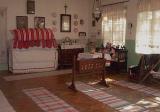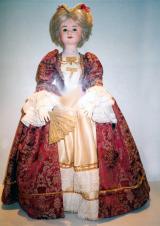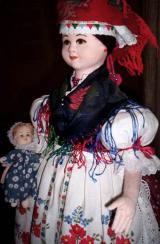2025. July 19. Saturday
Palóc Ethnographical Private Collection and Doll Exhibition - Mátrafüred

|
Address: 3232, Mátrafüred Pálosvörösmarti u. 2.
Phone number: (37) 320-137, (37) 320-183
E-mail: info@palocbabak.hu
Opening hours: Permanently
|
Our collection has functioned as a permanent exhibition here in Mátrafüred since 1983. At the begining our showrooms took places at different addresses until we found the permanent place 10 years ago. Nowadays the collection can be seen at the building of the old primary school (Pálosvörösmarti street 2.).
Szakács Józsefné started to collect the show-prieces 50 years ago. She travelled around the area of Palóc and bought the fancy works, textiles and folk costumes one by one in the villages. She elaborated the samplers that found there and her works were prised. She received the title of "Applied Artist of Folklore". Her "passion of collecting" was inherited by her grand-daughter, called Lovászné Juhász Rita, who studied as a costume designer.
The purpose of Lovászné J.R. was the elaboration of the folk (palóc) costumes. She got prises for her treats on applications and exhibitions. In 1987 she received the title of Applied Artist of Folklore, as well. Designing the costumes she tends to transmite the folk traditions via the creation of wearable clothes.
It is typical in the Area Palóc that every village has its own costume with different patterns. You can see the variablility via the 30 dolls folk costume. For example, the collection has show-piece that wears a costume of a bride and another and another that is wearing the costume of a bridegroom, or you can see a mother who is rocking her child in a cradle while another woman is doing some baker’s trade; you can also see "Máriás" girls, a woman who is wattleing or "guzsaly" with his husband or countrywomen returning from the fields. All of theese dolls show us the rustic lifestyle.
Another collection of dolls shows the Hungarian historic costumes. You can see the midlle-ages to the begining of the 1900's via watching dolls's costume. The 75 cm tall dolls are set out under glass and they are all handmade by textile. They are designed and created by Lovászné J.R. in her productive period of the last 10 years. The collection is renewed by the continuous creation of the dolls.
In our second salon you can see original, protected ethnic textiles from the begining of the 1900's on life-sized dummies. We show a young wife, a fianceé, a fiancé and an old lady, wearing 'vizitike'. You can see 'the clean room' - it is an enteriour for the guests - and the typical rustic furnitures, like the chest with tulip motive or benches, cradles, tables and beds with ornaments. In the other part of the showroom there are instruments of the quotidian rustic works and objects related with weaving. For example, the weaving loom - the 'szátva' - is an original show-piece. In case our visitors would like to see it in use we can show, how it works.
Lovászné Juhász Rita
Szakács Józsefné started to collect the show-prieces 50 years ago. She travelled around the area of Palóc and bought the fancy works, textiles and folk costumes one by one in the villages. She elaborated the samplers that found there and her works were prised. She received the title of "Applied Artist of Folklore". Her "passion of collecting" was inherited by her grand-daughter, called Lovászné Juhász Rita, who studied as a costume designer.
The purpose of Lovászné J.R. was the elaboration of the folk (palóc) costumes. She got prises for her treats on applications and exhibitions. In 1987 she received the title of Applied Artist of Folklore, as well. Designing the costumes she tends to transmite the folk traditions via the creation of wearable clothes.
It is typical in the Area Palóc that every village has its own costume with different patterns. You can see the variablility via the 30 dolls folk costume. For example, the collection has show-piece that wears a costume of a bride and another and another that is wearing the costume of a bridegroom, or you can see a mother who is rocking her child in a cradle while another woman is doing some baker’s trade; you can also see "Máriás" girls, a woman who is wattleing or "guzsaly" with his husband or countrywomen returning from the fields. All of theese dolls show us the rustic lifestyle.
Another collection of dolls shows the Hungarian historic costumes. You can see the midlle-ages to the begining of the 1900's via watching dolls's costume. The 75 cm tall dolls are set out under glass and they are all handmade by textile. They are designed and created by Lovászné J.R. in her productive period of the last 10 years. The collection is renewed by the continuous creation of the dolls.
In our second salon you can see original, protected ethnic textiles from the begining of the 1900's on life-sized dummies. We show a young wife, a fianceé, a fiancé and an old lady, wearing 'vizitike'. You can see 'the clean room' - it is an enteriour for the guests - and the typical rustic furnitures, like the chest with tulip motive or benches, cradles, tables and beds with ornaments. In the other part of the showroom there are instruments of the quotidian rustic works and objects related with weaving. For example, the weaving loom - the 'szátva' - is an original show-piece. In case our visitors would like to see it in use we can show, how it works.
Lovászné Juhász Rita


